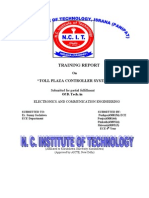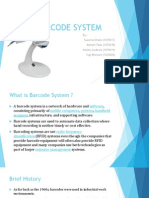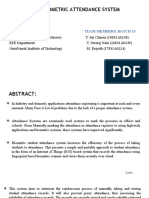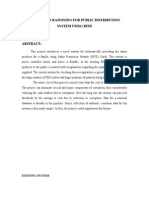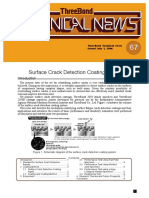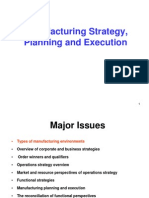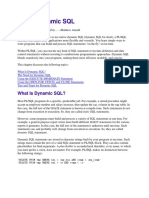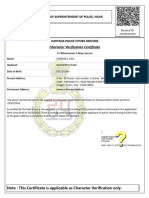Rfid Based Attendance System
Rfid Based Attendance System
Uploaded by
mveenavijayanmCopyright:
Available Formats
Rfid Based Attendance System
Rfid Based Attendance System
Uploaded by
mveenavijayanmOriginal Description:
Copyright
Available Formats
Share this document
Did you find this document useful?
Is this content inappropriate?
Copyright:
Available Formats
Rfid Based Attendance System
Rfid Based Attendance System
Uploaded by
mveenavijayanmCopyright:
Available Formats
RFID BASED ATTENDANCE SYSTEM
Background In all aspects of our life, we encounter event recording applications very often. Recording of any entity be it pictures, events etc. is very useful as it enables us to manipulate data to our requirements. One can exploit potential of the recorded information for specific user defined purposes. Keeping in mind the significance o recorders in todays world, we arrived at a common decision of making ATTENDANCE RECORDING SY USING RFID as our project in fulfillment of our B.E.(Electronics and Telecommunication) degree course.
Function An attendance recording systems basic function is to keep a record of the time at which the employees of a pa firm report to work and leave from work. It is one of the most widely used event recording application in the i today. A track of employee attendance is a must for payroll generation. The traditional method of maintain attendance register makes the job very tedious and prone to human errors. The collection and processing of employee. Attendance which may include leaves, half working days, overtime etc. and using it to generate the payroll m consumes important man hours, which in turn could be used to increase productivity and in turn profitably of th In case of an error, even more time will be used to detect and rectify it, if the process is manual. The whole proc be simplified to great extent. If a system is available by means of which attendance data be stored, accessed, sorted, and processed and obtain form of a detailed report which may be used directly for payroll generation, hence saving a lot of precious functions as a network of microchip smart tags and receivers. Each smart tag is embedded with a unique ele product code (EPC) and a micro-antenna. Once assigned, the EPC becomes a DNA-like marker for the item, iden it from every other item in the world. When a tagged item passes within range of a reader, the reader retrieves t via radio waves, identifies the item and its exact location, and relays this real-time information to a central co Taken together, the series of transactions comprise a comprehensive record of the tagged items movement from of origin to point of sale.
Comparison Manufacturers of time/attendance recorders (T/A recorders) in Taiwan offer mechanical/electronic and compute units. Most manufacturers provide computer-based models and only a few offer mechanical/electronic recorder T/A recorders in Taiwan fall within the midrange to high-end category. Computer-based models range in FO from Rs.10000 to Rs.15000, depending on the product's networking and access control features. Well,our prod be made at a cost of Rs.6000 (approx) and will include an onboard programmer. The person concerned will then to program the onboard microcontroller and will have access to the database.
User The product can be used by many organizations like our college itself. Whereby the traditional system of signin musters will now be replaced and replaced well by using tags allotted to the staff. However the current user is California startup called InCom has developed a radio frequency identification (RFID) system called InC automate attendance-taking in elementary and secondary schools. The system uses ultra-high frequency (UHF) mounted in classroom doorways and passive RFID tags attached to student ID card holders. A unique 15-d number is written to each tag and associated with the name of the student to whom it is issued. As the studen through the reader-generated interrogation field under a doorway, the reader sends the tags' unique ID numbe
central server. InCom has developed a software program, installed on the server, that collects the tag data and up list of present, absent and tardy (based on when they enter the classroom) students to a PDA that is issued teacher. Block Diagram
Block Diagram: RFID based Attendance System Explaination:
Microcontroller:
It is the Heart of the circuit. We will be using ATMELs AT89S52 microcontroller. The controller that we using is ATMELs AT 89s52, which is a 40 pin microcontroller with 32 I/O lines. The controller communicat the RFID reader & the PC using RS232 protocol for which MAX 232 IC is required.
MAX232:
Microcontroller communicates with the PC using its inbuilt Serial Port. The voltage levels are 0 & 5 Volts, but controller to communicate with the PC we are using RS232 protocol so for converting the CMOS (0-5) voltag into RS232 (12) voltage levels we will be using MAX 232.
Keypad:
The keypad is used to indicate if the person is entering or exiting the premise. So basically there will be two s one for enter & one for exit.
RTC:
Real Time Clock (RTC) is used to storing the real time. A battery is provided to the RTC so that even when th power failure the time is intact. The controller communicates with the RTC using the I2C protocol.
EEPROM:
EEPROM is used to store the LOGs of the person entering or exiting the premise. The EEPROM will con persons ID, time of scan & if the person is entering or exiting. The controller communicates with the EEPROM the I2C Protocol.
LCD:
We will be using 2-Line, 16 characters LCD. This will be used to display the real time, scan successful or not an such details.
Power Supply:
The complete circuit works on 5v this voltage is generated in the power supply section which basically consi step down transformer, a rectifier & a voltage regulator. The Advantages of RFID vs. barcode technology: No line of sight requirement. The tag can stand a harsh environment. Long read range. Portable database. Multiple tag read/write. Tracking people, items, and equipment in realtime. Advantages 1. Store data on a tag 2. Can be hidden 3. Work in harsh environment
Disadvantges 1. Lack of standards! 2. Short range 3. Cost
Applications 1. Livestock Tagging 2. Wild Animal Tracking 3. Electronic Article Surveillance (EAS) 4. Automated Toll Collection
You might also like
- Rfid Project ReportDocument65 pagesRfid Project Reportgsrawat123100% (1)
- Rfid Based Vehicle Monitoring and Toll Collection SystemDocument38 pagesRfid Based Vehicle Monitoring and Toll Collection SystemAbdul Razzak0% (1)
- Book DonationDocument15 pagesBook DonationJasdeep Singh Mahrok50% (2)
- Rfid Based Attendance SystemDocument5 pagesRfid Based Attendance SystemJeff ValerioNo ratings yet
- 5.chapter 1Document4 pages5.chapter 1thethtet87No ratings yet
- Chapppter Four & Five For JudeDocument14 pagesChapppter Four & Five For JudeoluwaseunNo ratings yet
- Rfid Access Control SystemDocument16 pagesRfid Access Control SystemManjeet SinghNo ratings yet
- Synopsis For RFid Based Attendance System NewDocument3 pagesSynopsis For RFid Based Attendance System NewMandar DeshmukhNo ratings yet
- RfidDocument15 pagesRfidravikiran261No ratings yet
- DSP PresentationDocument11 pagesDSP PresentationMuhammad Majid ZaheerNo ratings yet
- Employee Log System Using Pc&RfidDocument3 pagesEmployee Log System Using Pc&RfidThanniru VenkateshNo ratings yet
- Rfid Based Attendance System: Abstract - in Recent Past, A Rapid Growth in The Number ofDocument3 pagesRfid Based Attendance System: Abstract - in Recent Past, A Rapid Growth in The Number ofgandham vigneshNo ratings yet
- Tracking Police Man Using RF Proximity CardDocument6 pagesTracking Police Man Using RF Proximity CardSam JebaduraiNo ratings yet
- College AutomationDocument47 pagesCollege AutomationGauri Priya RohithNo ratings yet
- Atm Shoulder-Surfing Resistant Pin Entry by Using Base Pin and Base TextDocument3 pagesAtm Shoulder-Surfing Resistant Pin Entry by Using Base Pin and Base TextijaertNo ratings yet
- Application Design - HMSDocument3 pagesApplication Design - HMSsudhyiNo ratings yet
- Minor ReportFinalDocument34 pagesMinor ReportFinalPawan VishnoiNo ratings yet
- Examination Based On RfidDocument62 pagesExamination Based On Rfidsudhakar5472100% (2)
- The Design of PLC Entrance Guard System Based On RFID TechnologyDocument4 pagesThe Design of PLC Entrance Guard System Based On RFID TechnologyMIRCEA MIHAINo ratings yet
- Electronic Toll Collection Sysem Based On RfidDocument84 pagesElectronic Toll Collection Sysem Based On Rfidspiromarurthi50% (4)
- Ieee Paper On Image Processing Based On HUMAN MACHINE INTERFACEDocument6 pagesIeee Paper On Image Processing Based On HUMAN MACHINE INTERFACESuganya PeriasamyNo ratings yet
- Voice Activated Traffic Management System Using Apr 9600 Based On Embedded SystemDocument7 pagesVoice Activated Traffic Management System Using Apr 9600 Based On Embedded SystemInternational Journal of Scientific Research and Engineering StudiesNo ratings yet
- Design and Implementation of Low Cost Automatic Toll Collection System Using RFIDDocument6 pagesDesign and Implementation of Low Cost Automatic Toll Collection System Using RFIDGRD JournalsNo ratings yet
- Synopsis RfidDocument10 pagesSynopsis RfidneomayankNo ratings yet
- On Rfid Based Attendance System: Internet of Things Project ReportDocument36 pagesOn Rfid Based Attendance System: Internet of Things Project ReportNaveen KumarNo ratings yet
- RFID Based Employee Attendance System Complete ReportDocument174 pagesRFID Based Employee Attendance System Complete Reportvivek singh96% (27)
- RFID Based Attendance Management SystemDocument10 pagesRFID Based Attendance Management SystemBarid NayakNo ratings yet
- HMS RfidDocument23 pagesHMS RfidMahesh KumarNo ratings yet
- Electronic Toll Collection Sysem Based On RfidDocument68 pagesElectronic Toll Collection Sysem Based On RfidUmar Rahamatullah ShareefNo ratings yet
- Major Project On Toll Plaza Controller Syatem 2012 - OnvertedDocument38 pagesMajor Project On Toll Plaza Controller Syatem 2012 - Onvertedpoojabagri50% (2)
- RFID Based Attendance System Project Circuit and WorkingDocument5 pagesRFID Based Attendance System Project Circuit and WorkinglkjhNo ratings yet
- Research Review of Related LiteratureDocument9 pagesResearch Review of Related LiteratureBless beljNo ratings yet
- Smart Billing For Trolley Using RFIDDocument5 pagesSmart Billing For Trolley Using RFIDPrathyush P SNo ratings yet
- Ambulance Controlled Traffic System Using Rfid Technology With Labview SimulationDocument5 pagesAmbulance Controlled Traffic System Using Rfid Technology With Labview SimulationSimona NicoletaNo ratings yet
- Smart Shopping Cart IEEE PDFDocument4 pagesSmart Shopping Cart IEEE PDFradz248100% (3)
- Department of Electronics & Communication Engineering 1.modern Home (AC/DC) Automation Using GSM ModuleDocument4 pagesDepartment of Electronics & Communication Engineering 1.modern Home (AC/DC) Automation Using GSM ModuleSuresh ChintalaNo ratings yet
- Low Power Vlsi Circuits and Systems - Ajit PalDocument26 pagesLow Power Vlsi Circuits and Systems - Ajit PalAnushaNo ratings yet
- Barcode System MCTDocument27 pagesBarcode System MCTYogi BhimaniNo ratings yet
- Iot Based Biometric Attendance SystemDocument18 pagesIot Based Biometric Attendance SystemPrajoth 171A224No ratings yet
- RFID Based Security SystemDocument30 pagesRFID Based Security Systemletter2lalNo ratings yet
- Rfid Access Control System and Security WebcamDocument6 pagesRfid Access Control System and Security WebcamAjay BhaleraoNo ratings yet
- Presented By: Group No:8Document16 pagesPresented By: Group No:8Priyanka TrivediNo ratings yet
- Anytime Anyplace-Remote Monitoring of Students Attendance Based On Rfid and GSM NetworkDocument4 pagesAnytime Anyplace-Remote Monitoring of Students Attendance Based On Rfid and GSM NetworkAllyson WattsNo ratings yet
- RFID and GSM Based Smart TrolleyDocument4 pagesRFID and GSM Based Smart TrolleyIJARTETNo ratings yet
- Rfid SeminarDocument7 pagesRfid Seminaranon_344748121No ratings yet
- IvrsDocument11 pagesIvrsMuskan JainNo ratings yet
- RF Id Rationcard-OkDocument24 pagesRF Id Rationcard-OkRamalingam ShanmugamNo ratings yet
- Smart TrolleyDocument24 pagesSmart TrolleyAbdul Razzak0% (1)
- Smart TrolleyDocument24 pagesSmart TrolleyAbdul Razzak100% (1)
- Interactive Voice Response System: Bachelor of Engineering in Electronics & CommunicationDocument33 pagesInteractive Voice Response System: Bachelor of Engineering in Electronics & CommunicationSujeet KumarNo ratings yet
- RFID Based Security SystemDocument3 pagesRFID Based Security SystemBedanshu Shekhar MishraNo ratings yet
- CodeedDocument72 pagesCodeedAbhilashNo ratings yet
- Microcontroller Based Automated Attendance System For Employees Using Zigbee ModuleDocument5 pagesMicrocontroller Based Automated Attendance System For Employees Using Zigbee ModuleInternational Journal of Application or Innovation in Engineering & ManagementNo ratings yet
- Fully Automated Toll Tax Collection Using RF Technology. No Need To Stop Car On Toll GateDocument21 pagesFully Automated Toll Tax Collection Using RF Technology. No Need To Stop Car On Toll GatePraveen Kumar PrajapatiNo ratings yet
- Rfid Based Access Control For College Id CardDocument68 pagesRfid Based Access Control For College Id CardVindyachalTiwariNo ratings yet
- RFID OrganizedDocument19 pagesRFID Organizedgargikalia18No ratings yet
- Examples of Flow ChartDocument17 pagesExamples of Flow ChartLello Flo0% (1)
- EXP1Document6 pagesEXP1Ronny Fae FabonNo ratings yet
- (9.4.58) Adopting Latest IT Tools For Inventory Tracking & Its Management in OngcDocument8 pages(9.4.58) Adopting Latest IT Tools For Inventory Tracking & Its Management in OngcMuhammed SulfeekNo ratings yet
- Bus Data Entry System Project Report Content Write UpDocument16 pagesBus Data Entry System Project Report Content Write UpGarvit PrajapatiNo ratings yet
- StorekeeperDocument1 pageStorekeeperaswanth ajiNo ratings yet
- Tektronix Tds2012b DatasheetDocument9 pagesTektronix Tds2012b DatasheetJord primeNo ratings yet
- Hitec Cambridge School: Summer Task 2016 Pre O2 Subject DescriptionDocument3 pagesHitec Cambridge School: Summer Task 2016 Pre O2 Subject DescriptionshaziaNo ratings yet
- Surface Crack DetectionDocument8 pagesSurface Crack DetectionDaniel CringusNo ratings yet
- TD1005 Free and Forced Convection DatasheetDocument3 pagesTD1005 Free and Forced Convection DatasheetAissa HanifiNo ratings yet
- DHDT CompressorDocument18 pagesDHDT CompressorGeorge J AlukkalNo ratings yet
- Efficycle SaeDocument27 pagesEfficycle Saesampath siddamNo ratings yet
- Travel Motor - 325Document4 pagesTravel Motor - 325newmaktratoresNo ratings yet
- Lecture-4: 3.4 Relation Between Wire and Aperture AntennasDocument4 pagesLecture-4: 3.4 Relation Between Wire and Aperture AntennasSandeep Kumar PalaniswamyNo ratings yet
- Planning and ExecutionDocument89 pagesPlanning and ExecutionAkhilesh ChaudharyNo ratings yet
- Navarro College Medical Laboratory Technology Degree PlanDocument1 pageNavarro College Medical Laboratory Technology Degree PlanNavarro CollegeNo ratings yet
- Beginners Guide To ObservabilityDocument27 pagesBeginners Guide To ObservabilityItaloAGNo ratings yet
- Nexys4™ PDM Filter Project: Revised February 3, 2014 This Manual Applies To The Nexys4 Rev. BDocument12 pagesNexys4™ PDM Filter Project: Revised February 3, 2014 This Manual Applies To The Nexys4 Rev. Bvidhya dsNo ratings yet
- Features: 812 H - 1A - C XXVDCDocument4 pagesFeatures: 812 H - 1A - C XXVDCJULIO DOMINGUEZNo ratings yet
- Native Dynamic SQLDocument2 pagesNative Dynamic SQLRupesh PatraNo ratings yet
- Features Descriptio: LTC485 Low Power RS485 Interface TransceiverDocument12 pagesFeatures Descriptio: LTC485 Low Power RS485 Interface TransceiverSidumisile SikhosanaNo ratings yet
- PPTDocument36 pagesPPTShahina Shawls Shaa100% (1)
- Color Image ProcessingDocument189 pagesColor Image ProcessingruikarsachinNo ratings yet
- TGH-HSE-F0018 Lifting Plan Template LOCKEDDocument5 pagesTGH-HSE-F0018 Lifting Plan Template LOCKEDthana rajNo ratings yet
- MedisearchDocument51 pagesMedisearchNisha NairNo ratings yet
- Washer Reference Ebook Apr12Document146 pagesWasher Reference Ebook Apr12Nasser Anappara50% (2)
- Sensors: Camber Angle Inspection For Vehicle Wheel AlignmentsDocument12 pagesSensors: Camber Angle Inspection For Vehicle Wheel Alignmentsarun ranaNo ratings yet
- Na2xsy Aluminium Conductor Xlpe PVC Cable 1830 36 KVDocument2 pagesNa2xsy Aluminium Conductor Xlpe PVC Cable 1830 36 KVtyrone ramosNo ratings yet
- 817cn - Detector VoltDocument54 pages817cn - Detector Voltagus2kNo ratings yet
- JBL SR4731X Tech-Manual Rev ODocument2 pagesJBL SR4731X Tech-Manual Rev Omuzaky jackNo ratings yet
- AM340 - Manufacturing Processes and Materials PDFDocument376 pagesAM340 - Manufacturing Processes and Materials PDFDRNo ratings yet
- ENGR 302 Energy and EnvironmentDocument4 pagesENGR 302 Energy and EnvironmentYuna AnjosNo ratings yet
- Character Verification Certificate: Office of Superintendent of Police, HisarDocument1 pageCharacter Verification Certificate: Office of Superintendent of Police, Hisarsaharanvineet231100% (1)
- Dancing With GorillasDocument27 pagesDancing With GorillaskolehNo ratings yet





























